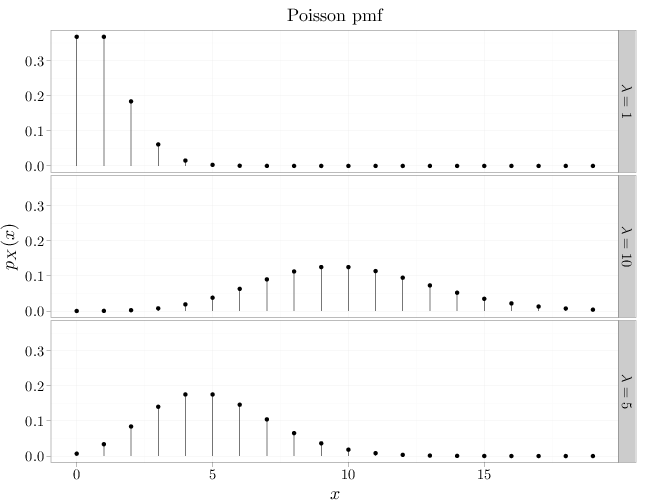3.6. The Poisson Distribution
The Poisson RV, $X\sim \text{Pois}(\lambda)$, where $\lambda>0$, has the following pmf \begin{align*} p_X(x)=\begin{cases}\frac{\lambda^x e^{-\lambda}}{x!} & x\in\mathbb{N}\cup\{0\}\\ 0 & \text{otherwise} \end{cases}. \end{align*}
Using Taylor expansion (Section D.2) we ascertain that $P(X\in\Omega)=1$: \[\sum_{x=0}^{\infty}\frac{\lambda^x e^{-\lambda}}{x!}=e^{-\lambda} \sum_{x=0}^{\infty} \frac{\lambda^x}{x!}=e^{-\lambda}e^{\lambda}=1.\]
We denote the pmf of $X\sim\text{Bin}(n,\theta)$ by $\text{Bin}(x\,;n,\theta)$ and consider the case where $n\to\infty$, $\theta\to 0$ and $n\theta=\lambda\in (0,\infty)$. Using the geometric series formula (see Section D.2), we have \begin{align*} \log \text{Bin}(x=0\,;n,\theta) &=\log (1-\theta)^n=\log (1-\lambda/n)^n = n \log(1-\lambda/n) \\ &= -\lambda - \frac{\lambda^2}{2n}-\cdots, \end{align*} implying that \begin{align*} \text{Bin}(x=0\,;n,\theta) \approx \exp(-\lambda). \end{align*} Similarly, \begin{align*} \frac{\text{Bin}(x\,;n,\theta)}{\text{Bin}(x-1\,;n,\theta)} &= \frac{n-x+1}{n}\frac{\theta}{1-\theta} = \frac{\lambda-(x-1)\theta}{x(1-\theta)} \approx \frac{\lambda}{x}, \end{align*} implying that \begin{align*} \text{Bin}(x=1\,;n,\theta) &\approx \frac{\lambda}{x} \text{Bin}(x=0\,;n,\theta)\approx \frac{\lambda}{1}\exp(-\lambda) \\ \text{Bin}(x=2\,;n,\theta) &\approx \frac{\lambda}{x} \text{Bin}(x=1\,;n,\theta)\approx \frac{\lambda^2}{2\cdot 1}\exp(-\lambda). \end{align*} Using induction, we observe that the pmf of $\text{Pois}(\lambda)$ approximates the pmf of $\text{Bin}(n,\theta)$ when $n\to\infty$, $\theta\to 0$ and $n\theta=\lambda\in (0,\infty)$. In other words, the $\text{Pois}(\lambda)$ RV is the number of "successes" occurring in a very long sequence of independent Bernoulli experiments ($n\to\infty$), each having very small success probability $\theta\to 0$, and further assuming that $0 < n\theta < \infty$.
The approximation above explains why many naturally-occurring quantities follow a Poisson distribution. Examples of such quantities are (see (Feller, 1968) for more details):
- the number of particles reaching a counter during the disintegration of radioactive material,
- the number of bombs landing in different regions of London during the Second World War,
- the number of bacteria found in different regions of a Petri dish,
- the number of centenarians (people over the age of 100) dying each year,
- the number of cars arriving at an intersection during a particular time interval, and
- the number of phone calls arriving at a switchboard during a particular time interval.
Using Taylor expansion (see Section D.2), we derive the mgf of the Poisson RV \begin{align*} m(t) =\sum_{k=0}^{\infty} e^{tk} \frac{\lambda^k e^{-\lambda}}{k!} =e^{-\lambda}\sum_{k=0}^{\infty} \frac{(e^{t}\lambda)^k }{k!} = e^{\lambda e^t-\lambda}, \end{align*} which leads to the following expectation and variance expressions: \begin{align*} \E(X) &= m'(0) = e^{\lambda e^t-\lambda}\lambda e^t\Big|_{t=0}=\lambda\\ \Var(X)& = \E(X^2)-(\E(X))^2 = m''(0)-\lambda^2 = \left(e^{\lambda e^t-\lambda}\lambda^2 (e^t)^2 +e^{\lambda e^t-\lambda}\lambda e^t \right)\Big|_{t=0} - \lambda^2 \\ &= \lambda. \end{align*} Proposition 4.8.1 states that the mgf of a sum of independent RVs is a product of the corresponding mgfs. Since the product of multiple Poisson mgfs with parameters $\lambda_i$ is also a Poisson mgf with parameter $\sum_i \lambda_i$, we have the following result: if $Z_i\sim \text{Pois}(\lambda_i)$, $i=1,\ldots,n$, are independent Poisson RVs then \[\sum_{i=1}^n Z_i \sim \text{Pois} \left(\sum_{i=1}^n \lambda_i\right). \]
x = 0:19 D = stack(list(`$\\lambda=1$` = dpois(x, 1), `$\\lambda=5$` = dpois(x, 5), `$\\lambda=10$` = dpois(x, 10))) names(D) = c("mass", "lambda") D$x = x qplot(x, mass, data = D, main = "Poisson pmf", geom = "point", stat = "identity", xlab = "$x$", ylab = "$p_X(x)$", facets = lambda ~ .) + geom_linerange(aes(x = x, ymin = 0, ymax = mass))
